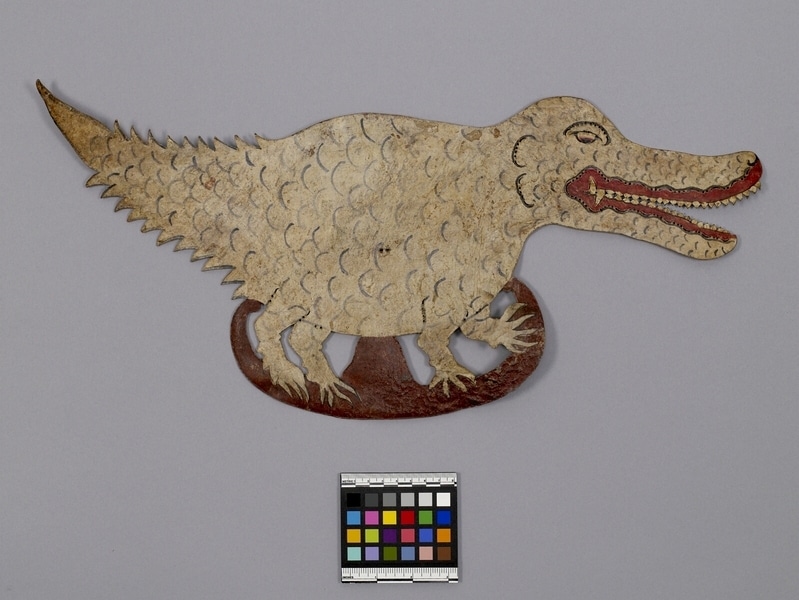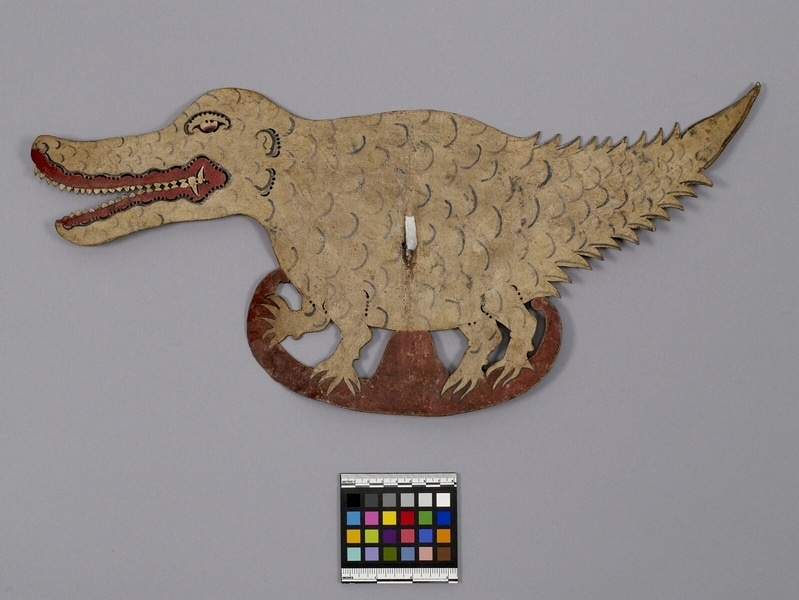Shadow Puppet Item Number: Ib269 from the MOA: University of British Columbia


Description
Reptile figure with open mouth, standing on a brown base that curls up at each end and in centre. Red lip prominent; fangs and teeth are off-white. Serrated tail. Tjempurit missing. Mouth, legs, eyes, gills accentuated by small holes and slits.
History Of Use
Javanese puppetry as an art form probably evolved by the 11th century. Originally the plays depicted Javanese mythology, but after the Indian conquest of Java the Hindu epics, Ramayana and Mahabharata, were incorporated into the play cycles. The arrival of Islam in the 1500's introduced Muslim philosophy which can be found in some plays. There are four traditional play cycles: an animistic cycle of legends; the Ardjuna Sasru Bau cycle; the Rama cycle; and the Pandawa cycle. These comprise about 200 plays. There have been numerous topical plays but the traditional ones are most often performed. An individual or group hires a dalang (puppet-master) to celebrate important occasions: births, weddings, thanksgivings or rites of passage. Special animistic plays are sometimes performed as part of an exorcism ritual. The performances often last all night, almost always presented in three acts with instrumental and vocal accompaniment. The individual plays vary widely in detail but usually involve conflict between noble heroes and their evil counterparts and demons. The plays serve a moral as well as religious purpose. Each puppet's character is represented by its appearance and placement onstage. Dominant nature is shown in size, shape, colour, and symbolic disposition; protagonists, with strong elements of good are placed to the right, antagonists of violent or unharmonious spiritual disposition to the left. Animals are common in the wayang purwa as supporting characters.
Iconographic Meaning
Reptile; animals often portray characters of minor importance.
Cultural Context
Theatrical performance.
Item History
- Made in Java, Indonesia
- Owned by Tradewind Antiques before March 15, 1983
- Received from Museum of Anthropology Shop Volunteers (Funding source) and Tradewind Antiques (Seller) on March 15, 1983
What
Who
- Culture
- Javanese
- Previous Owner
- Tradewind Antiques
- Received from
- Museum of Anthropology Shop Volunteers (Funding source) and Tradewind Antiques (Seller)
Where
- Holding Institution
- MOA: University of British Columbia
- Made in
- Java, Indonesia
When
- Ownership Date
- before March 15, 1983
- Acquisition Date
- on March 15, 1983
Other
- Condition
- good
- Current Location
- Case 61
- Accession Number
- 0886/0003